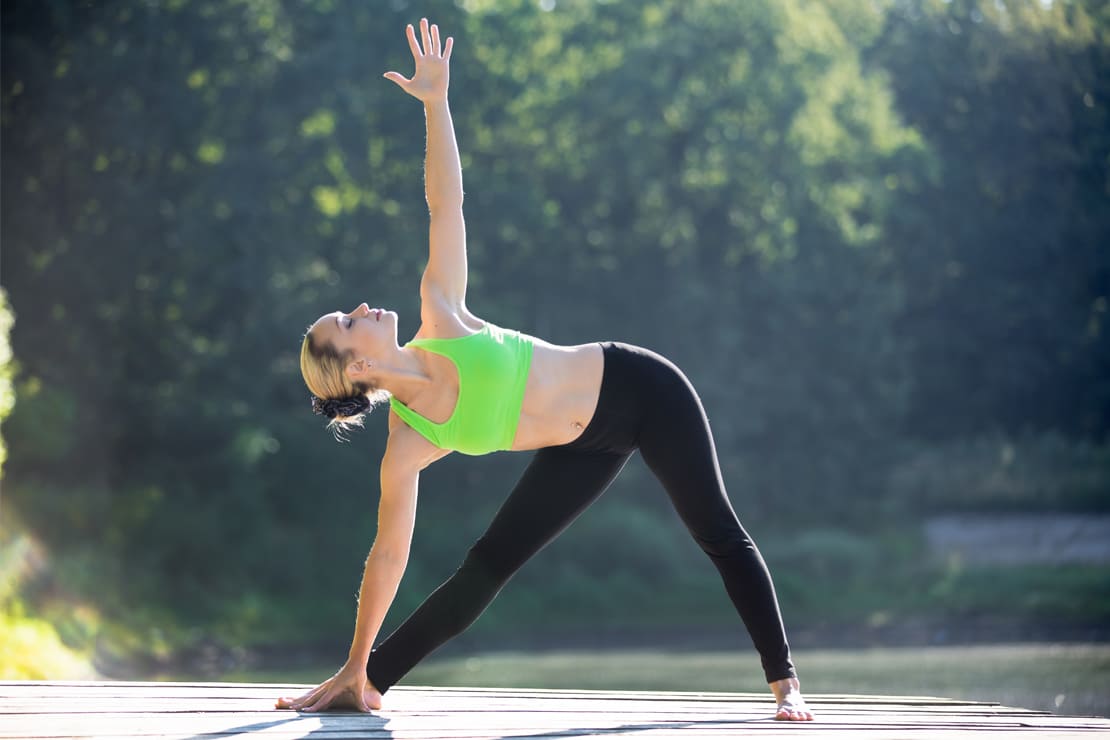Trikonasana, commonly known as the Triangle Pose, is a foundational yoga asana that stretches the entire body and helps improve balance and stability. Derived from the Sanskrit words “Trikona” (meaning triangle) and “Asana” (meaning posture or seat), Trikonasana engages the legs, core, and upper body, offering a wide range of physical and mental benefits. Here’s a comprehensive guide to performing Trikonasana, its benefits, and the precautions to keep in mind.

How to Perform Trikonasana (Triangle Pose)
1. Starting Position:
- Stand tall in Tadasana (Mountain Pose) with your feet together, arms at your sides, and your body relaxed.
- Take a deep breath and step your feet about 3 to 4 feet apart, creating a wide stance.
2. Position Your Feet:
- Turn your right foot outwards 90 degrees, pointing directly towards the right.
- Turn your left foot slightly inward, making a 45-degree angle. Make sure that your heels are in line with each other.
3. Extend Your Arms:
- Inhale deeply and raise your arms parallel to the floor, forming a “T” shape with your body. Keep your palms facing downward, shoulders relaxed, and arms firm but not stiff.
4. Bend Towards Your Right Side:
- Exhale as you begin to extend your torso to the right, bending from the hip joint rather than the waist. Keep your body long and stretched while maintaining the alignment of your spine.
- Lower your right hand towards your right shin, ankle, or the floor (if you’re flexible enough), depending on your comfort level. Your left arm should extend upwards towards the ceiling, forming a straight line with your right arm.
- Turn your head to gaze at your left hand, ensuring that your neck remains relaxed.
5. Engage Your Core:
- As you hold the pose, keep your core engaged to support the lower back. Both legs should be actively engaged, with your right thigh rotating outward and your left thigh rotating slightly inward.
- Hold the position for 5-10 breaths, feeling the stretch along your sides, hamstrings, and arms.
6. Release the Pose:
- Inhale to come back to the starting position, bringing your arms back to parallel and standing upright.
- Exhale and repeat the pose on the left side by turning your feet in the opposite direction.
Benefits of Trikonasana
- Full Body Stretch: Trikonasana provides a deep stretch to multiple muscle groups, including the hamstrings, calves, hips, shoulders, chest, and spine. It opens the sides of the body, creating more space in the torso and enhancing flexibility.
- Improves Balance and Stability: The pose engages the core muscles and strengthens the legs, helping improve balance, stability, and coordination. It also enhances body awareness, making it easier to maintain a sense of grounding.
- Stimulates Digestive System: The twisting motion of the torso in Trikonasana stimulates the abdominal organs, aiding digestion and improving metabolism. It can help relieve constipation and other digestive issues.
- Boosts Energy Levels: As a standing pose, Trikonasana activates the body’s energy and helps combat fatigue and lethargy. Regular practice of this asana improves overall vitality and energizes the mind and body.
- Strengthens the Spine: The pose helps improve posture by strengthening the spinal muscles and enhancing spinal flexibility. It also reduces the risk of developing back problems by promoting proper vertebral alignment.
- Reduces Stress and Anxiety: By focusing on deep, mindful breathing while holding the pose, Trikonasana helps calm the nervous system. It reduces stress, anxiety, and tension, making it an effective asana for mental relaxation.
Precautions for Trikonasana
- Avoid Rounding the Back: It’s important to maintain the natural alignment of the spine while bending. Avoid collapsing or rounding your back when reaching towards the ground. Keep the spine long and extended to prevent strain on the lower back.
- Engage Core Muscles: Always engage the core to protect the lower back during the pose. Without proper core activation, you may put excessive pressure on your back muscles, leading to discomfort or injury.
- Avoid Hyperextending the Knees: If you have hyperextension tendencies, be cautious not to lock or overextend the knees while practicing the pose. Keep a slight micro-bend in the knees to ensure joint safety.
- Be Cautious of Neck Strain: Turning the head to gaze at the upper hand can cause neck strain for some practitioners. If you experience discomfort, keep the head neutral, gazing straight ahead instead.
- Avoid Practicing with Certain Injuries: Individuals with serious neck, back, or shoulder injuries should avoid Trikonasana or practice it under the supervision of a qualified yoga instructor. Similarly, those with high or low blood pressure should exercise caution and consult a healthcare provider before practicing.
Conclusion
Trikonasana (Triangle Pose) is a powerful asana that stretches, strengthens, and energizes the body while promoting mental relaxation. It’s suitable for practitioners of all levels, though attention to alignment and precautions is key to avoiding injury. Trikonasana can significantly improve physical flexibility, balance, and overall well-being with regular practice.
